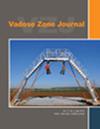Linking horizontal crosshole GPR variability with root image information for maize crops
IF 2.8
3区 地球科学
Q3 ENVIRONMENTAL SCIENCES
引用次数: 0
Abstract
Non-invasive imaging of processes within the soil–plant continuum, particularly root and soil water distributions, can help optimize agricultural practices such as irrigation and fertilization. In this study, in-situ time-lapse horizontal crosshole ground penetrating radar (GPR) measurements and root images were collected over three maize crop growing seasons at two minirhizotron facilities (Selhausen, Germany). Root development and GPR permittivity were monitored at six depths (0.1–1.2 m) for different treatments within two soil types. We processed these data in a new way that gave us the information of the “trend-corrected spatial permittivity deviation of vegetated field,” allowing us to investigate whether the presence of roots increases the variability of GPR permittivity in the soil. This removed the main non-root-related influencing factors: static influences, such as soil heterogeneities and rhizotube deviations, and dynamic effects, such as seasonal moisture changes. This trend-corrected spatial permittivity deviation showed a clear increase during the growing season, which could be linked with a similar increase in root volume fraction. Additionally, the corresponding probability density functions of the permittivity variability were derived and cross-correlated with the root volume fraction, resulting in a coefficient of determination (R2) above 0.5 for 23 out of 46 correlation pairs. Although both facilities had different soil types and compaction levels, they had similar numbers of good correlations. A possible explanation for the observed correlation is that the presence of roots causes a redistribution of soil water, and therefore an increase in soil water variability.玉米作物横向井间探地雷达变异与根系图像信息的关联研究
土壤-植物连续体内部过程的非侵入性成像,特别是根和土壤水分分布,可以帮助优化灌溉和施肥等农业实践。在本研究中,在德国塞尔豪森(Selhausen)的两个minihizotron设施收集了三个玉米作物生长季节的实时水平井间探地雷达(GPR)测量数据和根系图像。在6个深度(0.1 ~ 1.2 m)对2种土壤类型进行不同处理的根系发育和探地雷达介电常数监测。我们以一种新的方式处理这些数据,得到了“植被区趋势校正空间介电常数偏差”的信息,使我们能够研究根系的存在是否会增加土壤中GPR介电常数的变异性。这消除了主要的与根无关的影响因素:静态影响,如土壤异质性和根管偏差,以及动态影响,如季节性湿度变化。这种趋势校正的空间介电常数偏差在生长季节明显增加,这可能与根体积分数的类似增加有关。此外,导出了相应的介电常数变异概率密度函数,并与根体积分数交叉相关,46对相关对中有23对的决定系数(R2)大于0.5。虽然这两个设施的土壤类型和压实程度不同,但它们具有相似的良好相关性。对观察到的相关性的一种可能解释是,根系的存在导致土壤水分的重新分配,因此增加了土壤水分的变异性。
本文章由计算机程序翻译,如有差异,请以英文原文为准。
求助全文
约1分钟内获得全文
求助全文
来源期刊

Vadose Zone Journal
环境科学-环境科学
CiteScore
5.60
自引率
7.10%
发文量
61
审稿时长
3.8 months
期刊介绍:
Vadose Zone Journal is a unique publication outlet for interdisciplinary research and assessment of the vadose zone, the portion of the Critical Zone that comprises the Earth’s critical living surface down to groundwater. It is a peer-reviewed, international journal publishing reviews, original research, and special sections across a wide range of disciplines. Vadose Zone Journal reports fundamental and applied research from disciplinary and multidisciplinary investigations, including assessment and policy analyses, of the mostly unsaturated zone between the soil surface and the groundwater table. The goal is to disseminate information to facilitate science-based decision-making and sustainable management of the vadose zone. Examples of topic areas suitable for VZJ are variably saturated fluid flow, heat and solute transport in granular and fractured media, flow processes in the capillary fringe at or near the water table, water table management, regional and global climate change impacts on the vadose zone, carbon sequestration, design and performance of waste disposal facilities, long-term stewardship of contaminated sites in the vadose zone, biogeochemical transformation processes, microbial processes in shallow and deep formations, bioremediation, and the fate and transport of radionuclides, inorganic and organic chemicals, colloids, viruses, and microorganisms. Articles in VZJ also address yet-to-be-resolved issues, such as how to quantify heterogeneity of subsurface processes and properties, and how to couple physical, chemical, and biological processes across a range of spatial scales from the molecular to the global.
 求助内容:
求助内容: 应助结果提醒方式:
应助结果提醒方式:


